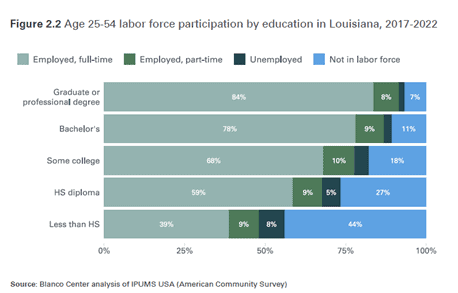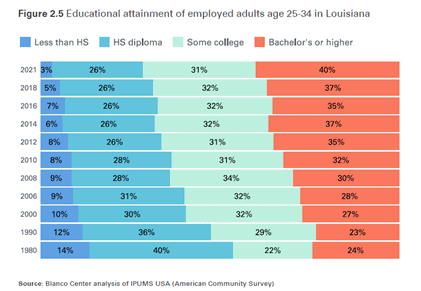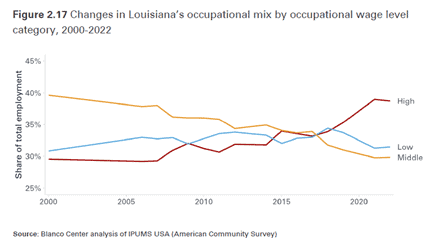
In 2023 the Louisiana Legislature passed legislation creating a data research system called LA FIRST. Housed at the Kathleen Babineaux Blanco Public Policy Center at the University of Louisiana at Lafayette, it creates a partnership with the center and seven state agencies to share data to help better understand what is happening in Louisiana in important policy areas.
The law currently requires the center to produce three annual reports to the Legislature focusing on, 1) the relationship between education credentials and employment outcomes, 2) student transition from high school to college or career settings, and 3) how education and employment impact involvement with various aspects of the criminal justice system.
This year the Blanco Center issued its first reports which Better Louisiana is highlighting in a series of data briefs beginning with their study on Louisiana Employment Outcomes.
Key Takeaways
- There has been significant growth in the number of certificate completers since 2010, while those earning bachelor’s and associate degrees have been largely flat.
- Far more women are completing degree programs than men. In 2023-24, the spread was 55% women to 44% men.
- There are strong wage outcomes for men earning associate degrees and short-term credentials. Men who earned associate degrees in 2014-15, had higher wages in 2023 than men who earned bachelor’s degrees in that same year, and more than women who also earned associate degrees in that same year.
- The report dove into four specific programs to show that that people earning LPN, RN, electrical, and HVAC degrees are seeing strong wage growth after they earn their degrees, and they tend to work in the occupation linked to their field of study.
Education Matters
Generally, wages in Louisiana increase as education attainment levels increase. This is true early in a worker’s employment, but especially later on as they advance in their careers.

Interestingly, the study showed that a cohort of men who earned an associate degree in 2014-15 actually had higher wages than those receiving a bachelor’s degree at the same time. This was not true for women, however. While more research on this is needed, the study suggests there are certain associate degree programs, particularly in technology fields, that are highly utilized and connect to well-paying jobs.
Labor force participation also appears to be a function of education. Those with higher levels of education are employed at higher rates. Between 2017 and 2022, a large percentage of the age 25-54 population with a high school degree or less, were either unemployed or not participating in the labor force.
Education Attainment Levels in Louisiana Have Increased
Louisiana’s workforce is significantly more educated than it was 40 years ago. In 1980 54% of workers between the ages of 25 and 34 had earned only a high school degree or less. Roughly 40 years later, the percentage of adults with no education beyond high school is still too high at 29%, but the percentage of workers with a bachelor’s degree or more has grown significantly from 24% to 40%.

The credential mix has also changed over the last decade or so. There has been a surge in both the number and percentage of completers who have earned a non-degree certificate or technical credential. Over the decade it has grown from about 7.5% to nearly 20% of all completers. This trend is expected to continue as Louisiana’s school accountability system and other policy initiatives increase both the opportunities and incentives for students to earn credentials while still in high school.
Interestingly, while the percentage of adults with a bachelor’s or doctorate degrees has remained relatively flat, the number with a master’s degree has grown. This seems to be attributable, at least in part, to the growth of online MBA programs.
Disparities Remain
Despite the positive growth in educational attainment across all groups of citizens, the data reveals there are still some clear disparities in terms of gender, race, and wages. Education attainment levels for White citizens continue to be higher than for African-Americans.
Interestingly, more women than men in Louisiana have earned associate’s, bachelor’s, and graduate degrees. This is true for both Black and White women and reflects a growth in education attainment levels for women that has been building in recent decades.
However, gaps remain when it comes to wages. Men still earn more than women at the same level of educational attainment. This could be attributed to gender disparity, but could also be related to such things as field of study, career choices, and family responsibilities. It should be noted that men earn more business and engineering degrees, while women earn significantly more health, social science, education and liberal arts degrees.
The Makeup of Jobs in Louisiana Has Been Changing
Over the last two decades, the percentage of both high and low-wage jobs in Louisiana has been increasing. This has come at the expense of those jobs in the middle. Data since 2000 show that these middle skill jobs, which tend to pay solid, mid-level wages, have declined precipitously from about 40% of the job mix to about 30% in 2022.

Other data sheds some light on what might be going on. Since 1990 the share of employment in Education and Health Services, Leisure and Hospitality, and Professional and Business Services have all been on the rise. But wages within these service sectors can vary greatly between high-wage professional service jobs and lower-wage food and hospitality work.
Meanwhile, the share of employment in Louisiana’s traditional business sectors such as Trade, Transportation, Utilities, Manufacturing, and Mining have all declined. These industries generally employed large numbers of people in relatively high-paying jobs that did not require a college degree. This is part of a national trend where the service sector has continued to grow while automation and global trade have reduced the numbers of various goods-producing jobs.
It should be noted that the pandemic created some significant skews in the trends involving high and low-wage job growth. We will have to wait for more recent data to fully understand where Louisiana stands today with regard to those jobs.
Case Studies: Training, Wages, and Employment
The report includes case studies looking at four occupations with well-defined training programs and examines the outcomes for workers after they have completed their training. The job occupations were Licensed Practical Nursing, Registered Nursing, Electricians, and HVAC Technicians.
While wages vary for each of these occupations there were some encouraging common findings:
- The majority of program completers were working in Louisiana during all the years that data was available for the study.
- The occupations of completers are highly-aligned to the instructional programs they participated in.
- After completion of their training, wages were significantly higher than they were before the training and there were patterns of sustained wage growth over the eight years these workers were observed.
Conclusion
The initial series of reports in the LA FIRST portfolio represents a starting point for showing what we can learn using longitudinal data that tracks outcomes over time. The ability to share and analyze data collected by different agencies is critical, because it allows us to begin to see how participation in various educational programs can impact employment, wages, and whether individuals educated and trained in Louisiana remain in the state.
The Blanco Public Policy Center is continuing to refine its approach to studying and analyzing this data with the goal of providing evidence-based research to help develop, improve, and change policies to benefit the citizens of Louisiana.
The full report is available here.
